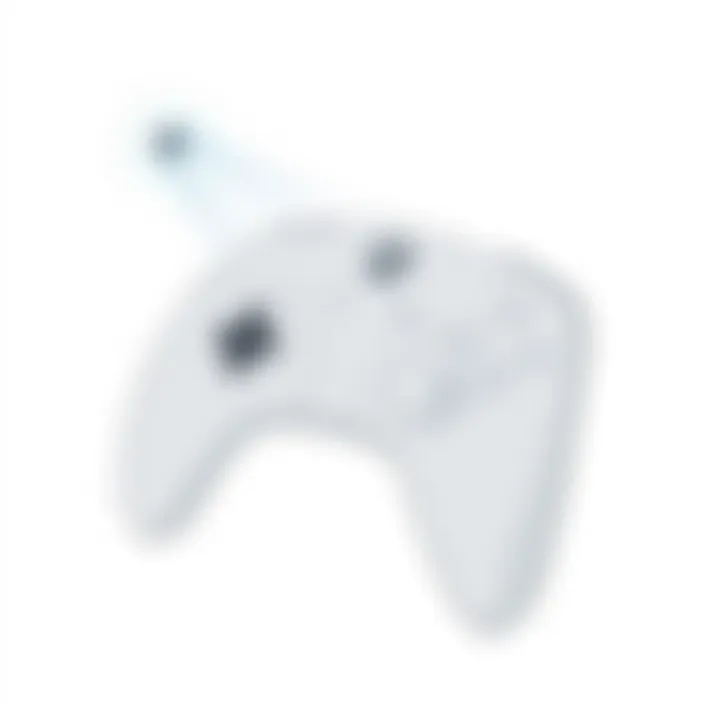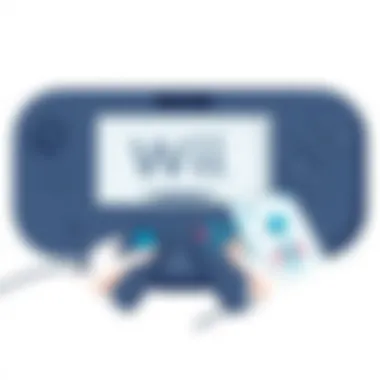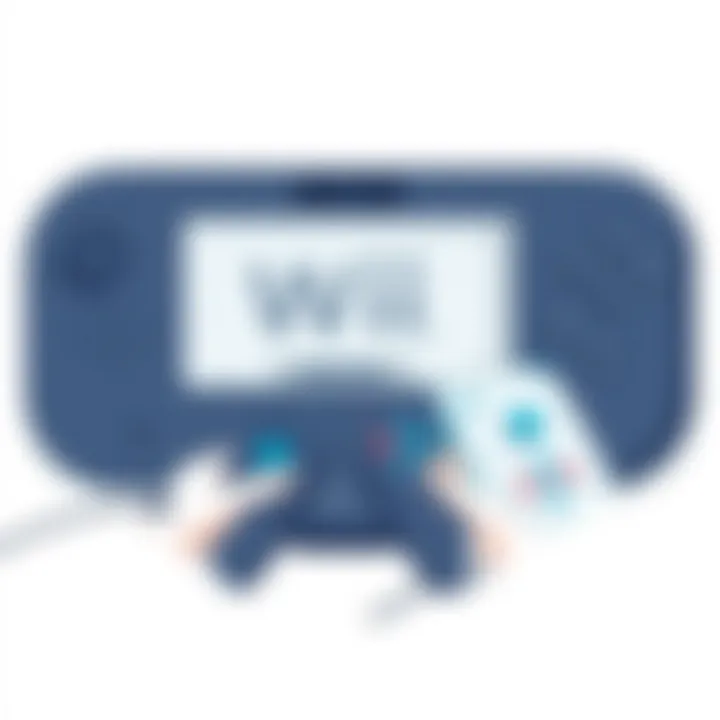Exploring the Top Wii Console Models and Features


Intro
The Nintendo Wii has long been a talking point for both gaming novices and seasoned players. This isn't just another console; it transformed how games were perceived and played. With innovative motion controls, it captured the hearts of many. Yet, similar to any piece of technology, it comes with a variety of models that cater to different needs and preferences. Therefore, understanding the various options available on the Wii platform is essential for both potential buyers and those looking to deepen their gaming experience.
Product Overview
Key Features
The Nintendo Wii consoles are not mere boxes of electronic circuitry; they came loaded with several standout features that set them apart from competitors. One significant aspect is the intuitive motion-sensing controls, which allow players to physically engage with the game environment. Other important features include:
- Game Compatibility: Access to a rich library of titles from various genres.
- Wireless Connectivity: Ability to connect to the internet for online gaming and downloading classic games.
- Backwards Compatibility: Many models also support GameCube games, offering a broader entertainment spectrum.
Technical Specifications
When reviewing consoles, specifications are crucial, and the Wii does not fall short here. Its architecture is designed to handle gaming demands effectively:
- CPU: 729 MHz Broadway processor
- GPU: 243 MHz Graphics processing unit
- Memory: 88 MB of RAM
- Storage: 512 MB internal memory
Pricing Information
Prices for the Wii can vary based on model and condition. As of now, you might find older models priced around $100 to $150, depending on their condition and included accessories. Special editions may command higher prices due to their rarity.
Performance Analysis
Benchmark Results
Performance benchmarks reveal the Wii can hold its own against contemporaries, focusing mainly on gameplay fluidity rather than graphic fidelity. Game experiences remain smooth, ballparking around 30 frames per second.
Real-World Use Cases
In real-world scenarios, the Wii shines in family or group settings. Motion games like "Just Dance" provide fun and energetic gameplay, making it ideal for parties or gatherings. Conversely, more intense titles like "The Legend of Zelda: Skyward Sword" showcase its ability to cater to serious gamers.
Comparison with Competitors
When lined up against contemporaries like the Xbox 360 or PS3, the Wii stands out due to its unique controller scheme and approachability. However, it may fall short in graphics compared to those systems.
Installation and Setup
Required Tools and Components
Setting up a Wii is a breeze; you typically just need the console, a power cord, video cable, and, of course, games to get started.
Step-by-Step Installation Guide
- Connect the power adapter to the console and plug it into a wall outlet.
- Attach the AV cable to the console and insert the other end into the TV.
- Power on your TV and switch to the correct input channel.
- Turn on the Wii console.
Troubleshooting Common Issues
If the console does not start, check the power outlet and ensure all connections are secure. For connectivity problems, refreshing the router settings often helps.
Pros and Cons
Advantages of the Product
- Unique and engaging control scheme
- Strong library of family-friendly games
- Ability to connect with Wii U for an expanded experience
Disadvantages or Limitations
- Limited graphics capabilities compared to current consoles
- Online connectivity can be less stable
- Smaller library of hardcore gaming titles
Who It’s Best Suited For
This console is perfect for families, casual gamers, and anyone looking to introduce gaming to new audiences. It's particularly appealing for parties where social play is paramount.
Final Thoughts
Summary of Key Points
The Nintendo Wii represents a paradigm shift in gaming, emphasizing motion controls and social interaction over graphical prowess.
Recommendations for Potential Buyers
If you're on the fence about which model to pick up, it’s best to opt for the Wii MotionPlus version, which enhances gameplay and provides more accuracy in motion tracking.
Future of the Technology or Product Line


While the Wii may not dominate today's gaming landscape, its innovative spirit lives on. The success of the Wii has had an enduring impact, guiding future technologies like augmented reality and motion-based gaming in devices like the Nintendo Switch.
Ultimately, the Wii remains an essential piece of gaming history, illustrating how interactive experiences can reshape entertainment and connectivity.
For more information, you can check out sources like Wikipedia or visit gaming communities on Reddit.
Explore the evolution of the technology and how it continues to influence the landscape of gaming.
Preface to the Wii Console
The Nintendo Wii stands as a landmark in gaming history, distinguishing itself from its contemporaries through innovation, accessibility, and pure fun. This introduction sets the stage for a comprehensive exploration of the Wii, illuminating not just its features but the cultural footprint it has left in the gaming world.
Historical Context
Launched in 2006, the Wii represented a bold departure from traditional gaming consoles that predominantly catered to a niche audience. Initially, many considered it something of an oddball in a landscape dominated by high-performance machines focused on graphics and realism. However, Nintendo’s decision to target a broader range of players paid off significantly. The Wii’s unique motion-sensing technology, which allowed players to physically engage with games, drew in not just hardcore gamers but families and casual players alike.
"The Wii was not just a console; it was a cultural phenomenon that reshaped how we interact with video games."
The console sold over 100 million units worldwide, making it one of the best-selling gaming systems of all time. Through its diverse game library, including titles like Wii Sports, it offered a social gameplay experience that encouraged group participation. Its design, which was subtle and non-intimidating, allowed players of all ages and abilities to pick up a controller and join in the fun. This was a game changer, fostering social gaming in a way that hadn’t been seen before.
Purpose and Audience
The purpose of this article is to delve deeper into the various iterations of the Wii console, its game offerings, and how it stacks up against its own lineage as well as rival systems. The audience is varied; on one hand, you have tech enthusiasts who appreciate the underlying mechanics and special features, and on the other, casual gamers who simply want an engaging experience without the steep learning curve often associated with console gaming.
Understanding the gaming landscape is essential to appreciate the Wii's success. For casual consumers, it’s about finding a console that brings friends and family together. For passionate gamers, it’s the thrill of dissecting its technological innovations and how they paved the way for today’s gaming experiences. This article aims to address both angles—highlighting technical specifications for the former while showcasing how various entertainment options can be enjoyed by the latter.
In essence, this section lays the groundwork for understanding what makes the Wii a significant part of the console conversation, paving the way for the subsequent detailed analysis of its models, technical specs, and user experiences.
Overview of Wii Models
When discussing the realms of video game consoles, the variations in models often signal not only technological advancement but also a shift in gaming experience. The Wii, a flagship offering from Nintendo, was designed not just for casual gamers but also aimed at broadening the appeal of video games. Understanding the different models of the Wii console is essential for anyone considering diving into the world of Nintendo gaming.
Wii Original
The original Wii console burst onto the scene in 2006, heralding a new era in gaming. It was not merely a piece of hardware; it was an invitation for family and friends to gather around and share in the fun. With its unique motion-sensing controls, the original Wii transformed traditional gaming into an interactive experience. The gameplay was as straightforward as a pie in the sky for even the youngest of players, making it appealing to a diverse audience.
Among its standout features is the Nintendo Wi-Fi Connection, allowing players to access a catalog of online multiplayer games and enjoy additional content. Moreover, the diverse library, ranging from The Legend of Zelda: Twilight Princess to party favorites like Mario Party, ensured that every player found something to cherish.
Wii Mini
If compactness and simplicity are the name of the game, the Wii Mini takes the cake. Released in 2012, the Wii Mini omits certain modern bells and whistles for a more stripped-down experience. The design is sleek, nearly resembling a toy, making it an inviting entry point for those new to gaming. The absence of internet connectivity turned some heads, but it forced players to embrace the joys of offline play, rekindling the classic couch co-op traditions.
While it only supports a selection of games from the original Wii library, it still has access to gems like Super Smash Bros. and Mario Kart Wii. Given its lower price and easy-to-use interface, the Wii Mini represents an appealing option, especially for families looking for occasional fun without the pressures of online gaming.
Wii U
The Wii U, released in 2012, took the ambitious leap from its predecessor's groundbreaking controls and aimed to merge handheld and home console gaming into one. With its unique GamePad featuring a built-in touchscreen, players could enjoy gameplay in a new, innovative way. The control scheme might have seemed a bit overwhelming, comparably speaking, but the advantages it offered were compelling. The Wii U allowed you to continue your game even if someone else was hogging the TV, which is no small feat in a multi-user household.
Furthermore, it hosted an expansive library of titles, notably Splatoon and Super Mario 3D World. This model also boasted enhanced graphics over the original, securing its status as a vital step forward in the evolution of Nintendo. However, its reception was mixed due to issues like poor marketing and a lack of third-party support, leaving some users scratching their heads.
Understanding these models provides readers not only with insight into their gaming options but also assists in making an informed choice based on personal preference and usability. Each model offers its own advantages and concerns, highlighting Nintendo's attempt to cater to a broader gaming demographic.
"The beauty of the Wii saga lies not only in the variation of its hardware but also in the memories created around it - from family game nights to solo quests. Finding the right model is as vital as the games that define it."
In the end, whether one is lured by the original Wii's charm, the simplicity of the Wii Mini, or the innovative features of the Wii U, there's no shortage of grabbing experiences to indulge in.
Technical Specifications Comparison
Understanding the technical specifications of any gaming console is crucial for discerning gamers who wish to optimize their experience. When it comes to the Wii consoles, specifics like processing power, memory, and video output capabilities pave the way for informed decisions. This section dissects these elements to enable potential buyers to grasp what each option can offer.
Processing Power and Graphics
The heart of any gaming console lies in its processing unit, and the Wii is no different. Its architecture might not match that of heavier hitters like the Xbox or PlayStation, but it’s designed to cater to a unique gaming experience that emphasizes accessibility and family fun over raw power.
The original Wii utilized a Broadway processor running at 729 MHz, which, while seemingly modest, provided enough horsepower for its intended audience. Developers crafted games around this specification, optimizing graphics to look vibrant without overwhelming the system. Titles such as Super Mario Galaxy showcase how creative design can work wonders, compensating for limitations with imaginative visuals.
“The Wii’s graphical prowess, while not top-notch, matched its game design, enticing users to engage, rather than merely gaze.”
As we look at the Wii U, the processing capabilities take a leap. The Wii U features multi-core processing, enabling more complex graphics and gameplay scenarios. With its enhanced GPU, games now offer richer textures and deeper visual narratives. The graphics chip handles HD output well, pushing the console between the realms of casual gaming and more serious visual demands. In essence, while the original Wii catered to a specific audience, the Wii U broadened its appeal, providing a more graphically intense and immersive experience.
Memory and Storage Options
Memory and storage have always played a pivotal role in determining how users interact with their gaming platform. The original Wii, equipped with a paltry 512 MB of internal flash memory, presented challenges for those wishing to download and store numerous titles. While this was sufficient for some casual gamers, more engaged users felt the limits. Thankfully, Nintendo offered the option for external storage via SD cards, allowing for some leeway in terms of game storage and data management.
Conversely, the Wii U vastly improved on this aspect, kicking off with 8 GB or 32 GB of internal storage, depending on the model. This expansion facilitated a more robust library, allowing players to download digital games directly and even engage with online multiplayer experiences seamlessly. Moreover, the ability to use external hard drives means that avid gamers can stockpile titles without a hitch, turning their consoles into sizeable gaming libraries.


Video Output Capabilities
When it comes to video output, the consoles demonstrate a clear evolution from the original Wii to the Wii U. Initially, the original Wii provided a 480p output, relatively low by today’s standards. This was suitable for its target demographic, focusing on casual play without overwhelming users with unnecessary visual fidelity.
In contrast, the Wii U’s capabilities extend to 1080p, enabling it to support HD gaming, a massive draw for many consumers in today’s market. The greater resolution means that games like The Legend of Zelda: The Wind Waker HD transmute into breathtaking experiences, revealing a level of detail that revitalizes the classics. Furthermore, connecting to high-definition TVs allows users to enjoy the games in all their glory, enhancing both visuals and gameplay immersion.
To sum it up, when evaluating the technical specifications of the various Wii models, it’s apparent that each version has its strengths and weaknesses. From processing power that affects gameplay to the memory options that dictate what a gamer can store, choosing the right console hinges on identifying personal priorities. As games continue to evolve, understanding these technical aspects becomes essential for making the most informed decisions in this intricate digital age.
Gameplay Experience
The gameplay experience is the heart and soul of any gaming console, and when it comes to the Wii, this aspect stands out remarkably. Its unique approach to gaming breaks the conventional boundaries set by earlier platforms. The intricacy of player interaction, emotional engagement, and the sheer joy of exploration all derive from the way Wii presents its games. Here, we will delve into several glaring components that shape this engaging experience.
Unique Control Mechanisms
The control systems of the Wii thwart heavy reliance on traditional button-mashing. Instead, it goes for motion-sensing technology, allowing players to literally step into the shoes of their characters—swinging, throwing, and even dancing their way through games. The Wii Remote, often paired with the Nunchuk, uses accelerometers and sensors to transform mundane movements into meaningful gameplay.
For instance, in a game like Wii Sports, players mimic real-life activities such as bowling or tennis by swinging their remote just as one would a real racket or bowling ball. This immersion feels refreshingly different. But it’s not without its quirks.
"I've seen my friends flail about wildly, completely missing their targets, thanks to the sensitive controls. It's part of the charm, really."
Players often share anecdotes about how intuitive nudges and flicks led to spontaneous laughter and delight. Yet, for some hardcore gamers, this could feel a tad too casual, even as the appeal for families and non-gamers is unmistakably higher. A balance of challenge and fun remains the key.
Game Library Overview
No discussion about gameplay experience can neglect the rich arsenal of titles available for the Wii. It has something for just about everyone. The game library features classics like Super Mario Galaxy, praised for its creativity and design, and thrilling sports experiences in games like Mario Kart Wii, which invites both competition and cooperation.
Moreover, the console encourages titles that cater to an inclusive audience—families can come together, whether playing party games like Just Dance or engaging in cooperative puzzles. The conversation around game selection is a complex one, as preferences vary widely.
- Nostalgic Favorites: Many gamers return for a trip down memory lane with timeless classics.
- Innovative Titles: Developers experimenting with the hardware have birthed a plethora of innovative titles that challenge traditional gaming experiences.
It's worth noting that this game library could be seen as a double-edged sword. While its diversity is commendable, some may find that it lacks the hardcore, action-driven options present on competitors' platforms. However, the charm and accessibility make it an evergreen choice for families and casual players alike.
Multiplayer and Social Features
One cannot overlook the significance of social gaming in the Wii’s legacy. The console doesn't just promote a gaming environment; it actively fosters community by encouraging multiplayer experiences. Devices like the WiiConnect24 add layers to the social aspect by allowing users to share or even download stage content and achievements.
The inherent multiplayer games cultivated excitement during get-togethers. Whether it’s stacking blocks in Wii Party or competing in various sports in Wii Sports Resort, the fun multiplies when you play with others. It invigorates gatherings, transforming any living room into a mini-competition arena.
Key Highlights of the Multiplayer Experience:
- Accessibility: Simple controls mean friends and family, even those unfamiliar with gaming, can jump right into the action.
- Collaborative Gameplay: Many games require teamwork, building camaraderie as players strategize together.
- Competitive Atmosphere: The excitement of friendly rivalry adds spice.
Ultimately, the multiplayer and social aspects of the Wii shape an atmosphere where laughter and shared experiences become cherished memories. As we examine the aggregate of these gaming experiences, it’s clear that the Wii has secured its place in the hearts of both casual gamers and enthusiasts.
User Reviews and Reception
Understanding how the Wii console has been received by users is crucial, as it sheds light on real-world experiences that manufacturer specifications often overlook. This section aims to highlight the importance of user reviews and reception in offering a more holistic view of the Wii's legacy. User opinions not only reflect the operational reliability and gaming satisfaction but also reveal patterns in usage that technical reports might miss. Additionally, they provide insights into the cultural relevance of different models, catering both to the tech-savvy gamers and casual users alike.
Critical Acclaim
The Wii has garnered a plethora of critical acclaim since it first hit the market in 2006. This can be attributed to its innovative approach to motion controls and family-friendly gaming, which appealed to a diverse audience. Critics lauded the console for breaking barriers and attracting non-gamers into the fold. It was not just about flashy graphics or complex storytelling; it was about a shared experience, bringing families and friends together for fun outdoor-centric games like Wii Sports and Just Dance.
- Press Reception: Many gaming outlets rated the console high for its novelty and user-friendly design. This initial excitement often translated into solid sales figures and a strong launch lineup.
- Industry Impact: The Wii's influence has been noted in subsequent gaming consoles and their designs, specifically in how they approach user interaction.
"The Wii helped redefine what gaming could be in terms of accessibility and social engagement.”
User Feedback Analysis
User feedback around the Wii has been fairly extensive, ranging from heartfelt endorsements to critical observations. Reviews often touch on several points, such as gameplay experience, system stability, and longevity.
- Gameplay Enjoyment: Many users find the games not only entertaining but also physically engaging. Titles like Super Mario Galaxy and Zelda: Twilight Princess received high praise, leading fans to label the comfort of gameplay as one of its major selling points.
- Technical Issues: Some users expressed concerns over technical difficulties, like the sensitivity of the motion controls or issues with console connectivity.
Long-term User Satisfaction
When we consider long-term user satisfaction, many Wii owners have turned to nostalgic reflections about their experiences. It’s not just about the immediate joy of gameplay, but also the lasting connections formed through shared gaming.
- Nostalgia Factor: As time passes, fond memories have led many players to keep their consoles for years. They frequently cite unforgettable nights spent playing with friends and family, making the Wii a central part of their gaming history.
- Comfort With Updates: Other aspects of long-term satisfaction can be seen through the use of homebrew applications or modifications that allow users to broaden their gaming library. While some players embraced these options, others felt uncertain about the longevity of support from Nintendo itself.
In summary, analyzing user reviews and the overall reception of the Wii aids in grasping the broader sentiment toward this console. By shallow diving into critical acclaim, user feedback, and long-term satisfaction trends, we not only enrich our understanding of the Wii’s impact but also place ourselves in a position to make informed recommendations regarding the most fitting model for potential buyers.
Compatibility and Accessories
In the world of gaming, compatibility and accessories play a pivotal role in shaping the overall experience. For enthusiasts and casual players alike, having a clear understanding of what games and add-ons work seamlessly with the Wii console can greatly enhance enjoyment. Compatibility with various games and formats ensures that users get the most out of their console, while accessories can elevate gameplay, making it more engaging and immersive.
Compatible Games and Formats


When it comes to the Wii console, the library of games is astonishingly vast. From family-friendly titles to enriching adventure games, compatibility extends beyond just console types. The Wii supports a range of game formats including regular Wii discs, Virtual Console games, and even GameCube titles. Here’s a breakdown:
- Wii Discs: Most popular games like Super Mario Galaxy and The Legend of Zelda: Skyward Sword are available in physical disc format, which runs directly on any Wii model.
- Virtual Console: This digital service allows users to download classic titles from previous Nintendo systems. Games from the NES, SNES, and N64 are among the treasures one can find here.
- GameCube Games: A hidden gem is the backward compatibility with GameCube games. Titles like Super Smash Bros. Melee still find a dedicated audience on the Wii.
Each of these formats has unique characteristics that appeal to different players. Remember, however, that certain models, like the Wii Mini, lack backward compatibility, limiting access to this rich catalog of games.
Essential Accessories
Accessories can make a significant difference in gameplay, enabling new experiences and increasing the fun factor. For the Wii, several accessories stand out:
- Wii Remote and Nunchuk: The foundational accessories for any Wii experience. These controllers work together to provide motion sensing for a wide array of games, from sports to shooting.
- Classic Controller: Perfect for those who prefer a more traditional gaming experience. It connects to the Wii Remote and is fantastic for playing Virtual Console titles.
- Wii Balance Board: This accessory was designed for fitness games like Wii Fit and offers an interactive way to engage in physical activity at home.
Moreover, additional accessories like steering wheels for racing games, or even charging docks for batteries, bring a new level of convenience and fun. It’s essential to match accessories with personal interests, as they significantly alter game interaction.
"Finding the right games and accessories is akin to picking the perfect pair of shoes; each should match the adventure you aim to pursue."
In summary, understanding compatibility and selecting the right accessories can transform a standard gaming experience into something exceptional. Whether you’re stacking up classic titles or racing with friends using a wheel accessory, the richness of the Wii ecosystem lies in its flexibility and variety.
Market Availability
The topic of market availability is pivotal for anyone interested in the Wii console options. Understanding where to get these consoles, whether new or used, can greatly influence a consumer's decision. The landscape has changed since the Wii's launch, impacting how easily one can find these devices and at what cost. This section provides an in-depth look at the purchasing dynamics surrounding the Wii, factoring in considerations like product condition, longevity of service, and the potential for saving costs.
Purchasing New vs. Used
When it comes to acquiring a Wii console, buyers generally face two primary options: purchasing new or opting for a used unit. Each choice comes with its own set of benefits and drawbacks.
- Buying New: The advantages are straightforward. New consoles often come with a warranty that can provide peace of mind. Retailers typically offer the latest models and accessories, ensuring users have all the bells and whistles right out of the box.
- Drawing from a Pool of Used Consoles: One can often find used Wiis at bargain prices, especially through platforms like eBay or local classifieds. However, buyers should exercise caution. Unlike new consoles, used units may come with wear and tear, possibly impacting functionality. The affordability factor here can't be ignored, as savvy shoppers can score excellent deals if they know what to look for.
"Navigating the second-hand market requires a keen eye for details. Just because it's priced low doesn't mean it's a worthy purchase."
Before making a decision, think about the condition of the console, any potential for repairs, and the feel of nostalgia that a used unit might bring. It's wise to read consumer reviews specifically concerning the seller's reputation.
Pricing Trends
Tracking pricing trends for the Wii consoles reveals a lot about their market lifecycle and consumer interest. Initially launched at a relatively low price point, the demand skyrocketed, and prices reflected that increase. Here are a few key observations about the pricing landscape:
- Initial Price Drops: Over the years, both the Wii Original and the Wii U saw price reductions, especially as newer consoles emerged in the market.
- Used Market Dynamics: Prices for second-hand consoles can swing significantly based on the console’s condition, included accessories, and market demand. Certain games, particularly those exclusive to the Wii, can still fetch high prices even in the used market.
- Geographic Variability: Prices can also vary by region. In some areas, the Wii remains a popular item, while in others, it’s becoming harder to find. Online platforms, however, tend to level the playing field, making it easier to find competitive pricing regardless of location.
In summary, whether considering new or used options, the market availability of Wii consoles reflects a complex interplay of factors that can greatly influence a buyer's choice. By being mindful of where and how to purchase, potential buyers can make informed decisions that suit their needs and budget.
Future of the Wii Brand
The trajectory of the Wii brand, despite its hiatus in new releases, remains a topic of considerable interest in the gaming community. The impact it made during its prime years is still felt, and understanding its future can reveal much about the evolution of video gaming itself. Analyzing the future of the Wii brand not only helps to appreciate its legacy but also provides insight into how it may influence budding technology in the console market.
Influence of Wii on Modern Consoles
When the original Wii launched in 2006, it shook the foundations of console gaming with its introduction of motion controls. Unlike its competitors, the Wii wasn’t concerned with sheer graphical power; it prioritized intuitive gameplay, drawing in a broader audience. This revolutionary approach changed how gamers interacted with their consoles and ultimately impacted subsequent devices.
Modern consoles, such as the Nintendo Switch, have incorporated similar ideas, blending traditional game mechanics with motion capabilities and portability. The Wii's philosophy of accessibility can be seen in the way newer consoles promote social gaming experiences and cater to players of various skill levels.
"The Wii did not merely start a trend; it transformed the gaming landscape, making it more inclusive and inviting to new players."
The robust game library of the Wii, which included titles that were easy to grasp yet difficult to master, set a precedent that game developers continue to follow. These principles contribute to the ongoing evolution of gaming, emphasizing that fun and engagement often trump the technical specifications.
Legacy and Cultural Impact
The cultural impact of the Wii extends beyond the realm of gaming. It helped foster a tide of fitness games, establishing new genres and pushing boundaries on how consoles could be utilized. Titles like Wii Fit capitalized on the growing interest in health and wellness, demonstrating that gaming could be both entertaining and beneficial. This aspect continues to influence how games are designed and marketed, merging play with productivity.
The Wii also played a significant role in family gaming culture, bridging generational gaps through multiplayer experiences. It encouraged group play rather than solitary sessions, reinforcing the idea that gaming can be a communal activity. This aged well as newer titles and consoles strive to maintain this social connectivity, proving that the roots laid by the Wii are still relevant.
For a deeper dive into the history and evolution of gaming consoles, you can check resources like Wikipedia's video game console article or explore various communities discussing such impacts on platforms like Reddit.
Ultimately, while times change and technology advances, the foundational principles introduced by the Wii remind us that gaming's essence remains: creating connections and providing enjoyment.
Finale and Final Thoughts
In reflecting on the various iterations of the Wii console, it becomes evident that the significance of these gaming systems transcends mere hardware and software features. This analysis gleaned insights into how the Wii models speak to different segments of the gaming community, from dedicated enthusiasts to casual players. Furthermore, the interaction between innovative controls and multiplayer features has shaped user experiences in profound ways.
The importance of this section lies in its synthesis of the extensive information provided throughout the article. Here, we appreciate the compatibility, user reviews, and overall gameplay experience, anchoring them within the broader context of gaming history. The Wii has certainly carved a niche that challenges traditional gaming norms, promoting inclusivity and interactivity. As technological advancements continue to grow, understanding the legacy of these models offers a roadmap to what the future may bring.
Another benefit of assessing the Wii’s impact is the consideration of its cultural relevance. The social gaming element, facilitated by the unique motion controls, fosters connections among friends and family, creating memorable experiences. As younger generations jump into the gaming arena, they too are catching wind of the Wii’s charm, sometimes through older family members who reminisce about their gaming sessions.
Ultimately, this conclusion serves not just to wrap up the analysis but to invite ongoing discussions about the role gaming consoles play in our lives—advancing technology while nurturing relationships. With all these key takeaways, one can recognize that choosing the right Wii model is not merely about specifications; it’s about understanding personal engagement with games and the broader gaming landscape.
"Video games are not just an escape, they're a connection to each other."
Summary of Key Points
- The Wii comprises various models like the Original, Mini, and U, each catering to different gameplay needs.
- Technical specifications such as processing power, memory, and video output were pivotal in determining user experiences.
- User reviews reveal insights into critical aspects like long-term satisfaction and the perception of gameplay mechanics.
- Compatibility with games and available accessories enhance overall enjoyment and engagement.
- The influence of the Wii on modern gaming can't be overstated; it paved the way for a more inclusive gaming culture.
Recommendation of Best Wii Model
- For those diving into the world of Wii gaming for the first time, selecting the right model is crucial. The Wii U stands out as the top recommendation given its versatility. Not only does it support an expansive library of Wii games, but it also introduces features like the GamePad—a unique addition that enhances gameplay.
- On the flip side, the Wii Original remains a solid choice for players who prefer simplicity and nostalgia, offering a straightforward gaming experience that captures the joy of the original Wii model.
- For budget-conscious gamers, exploring used options can yield significant savings, but it’s advisable to ensure condition and compatibility with desired games are checked.



